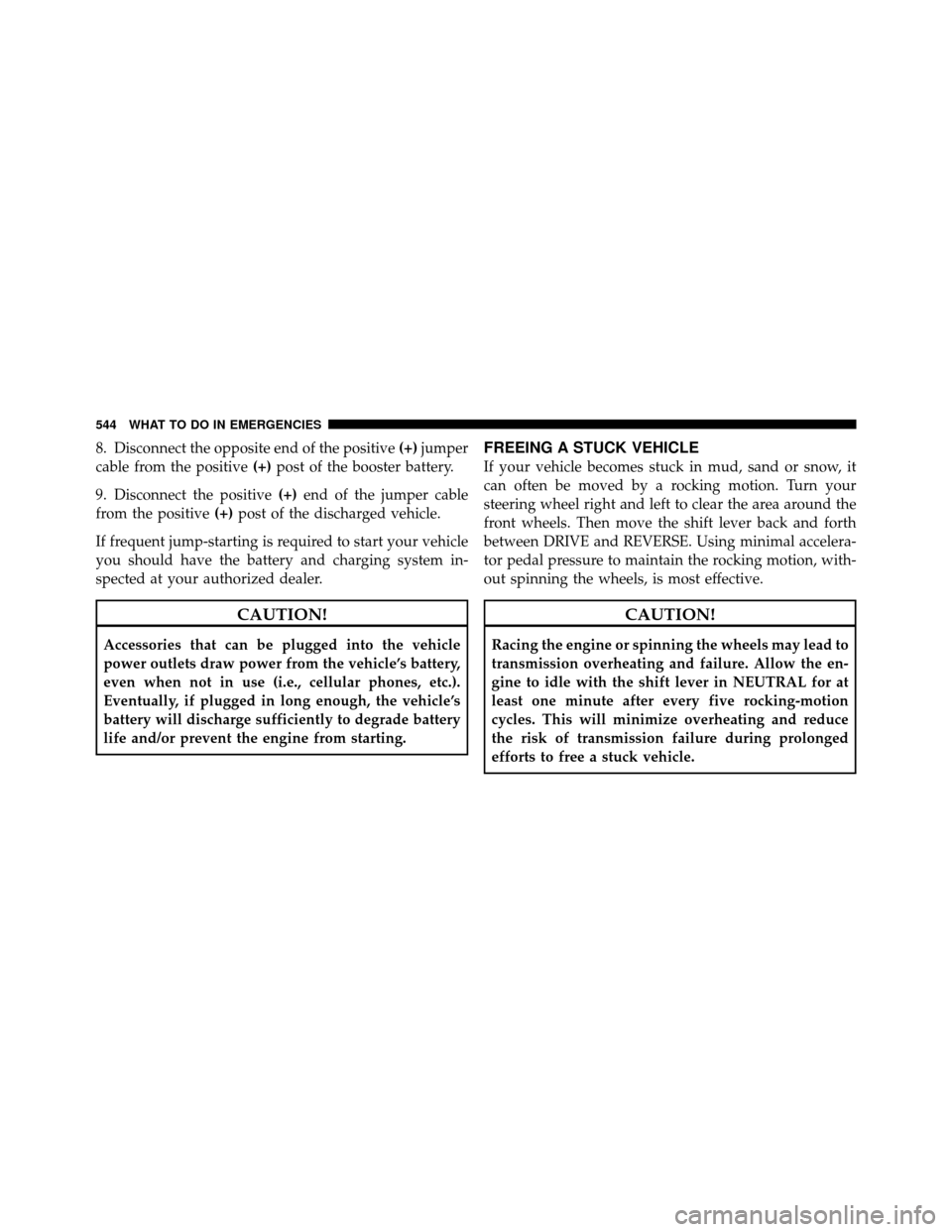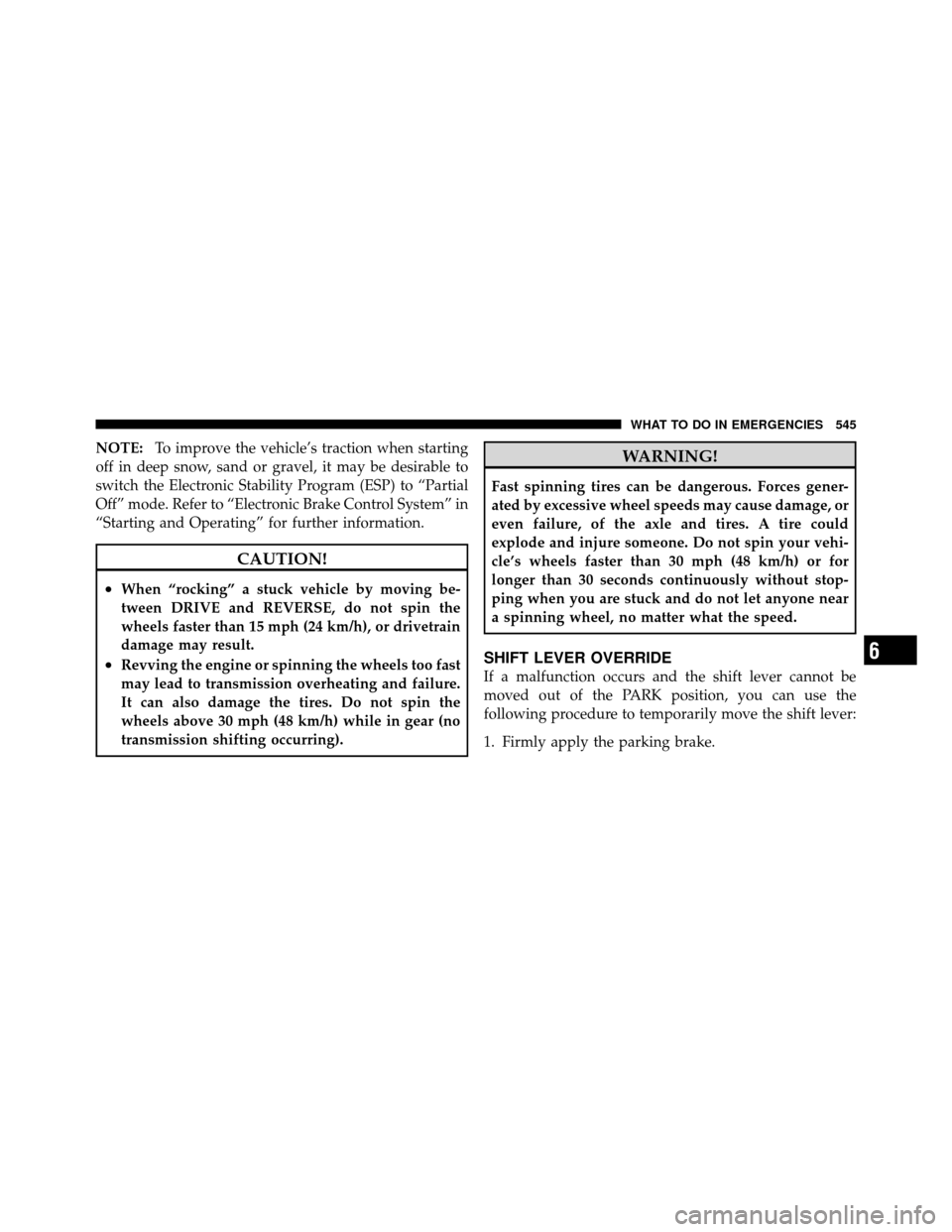Page 545 of 652

CAUTION!
Failure to follow these procedures could result in
damage to the charging system of the booster vehicle
or the discharged vehicle.
1. Connect the positive (+)end of the jumper cable to the
positive (+)post of the discharged vehicle.
2. Connect the opposite end of the positive (+)jumper
cable to the positive (+)post of the booster battery.
3. Connect the negative end (-)of the jumper cable to the
negative (-)post of the booster battery.
4. Connect the opposite end of the negative (-)jumper
cable to a good engine ground (exposed metal part of the
discharged vehicle’s engine) away from the battery and
the fuel injection system.
WARNING!
Do not connect the cable to the negative post (-) of the
discharged battery. The resulting electrical spark
could cause the battery to explode and could result in
personal injury.
5. Start the engine in the vehicle that has the booster
battery, let the engine idle a few minutes, and then start
the engine in the vehicle with the discharged battery.
Once the engine is started, remove the jumper cables in
the reverse sequence:
6. Disconnect the negative (-)jumper cable from the
negative (-)post of the vehicle with the discharged
battery.
7. Disconnect the negative end (-)of the jumper cable
from the negative (-)post of the booster battery.
6
WHAT TO DO IN EMERGENCIES 543
Page 546 of 652

8. Disconnect the opposite end of the positive(+)jumper
cable from the positive (+)post of the booster battery.
9. Disconnect the positive (+)end of the jumper cable
from the positive (+)post of the discharged vehicle.
If frequent jump-starting is required to start your vehicle
you should have the battery and charging system in-
spected at your authorized dealer.
CAUTION!
Accessories that can be plugged into the vehicle
power outlets draw power from the vehicle’s battery,
even when not in use (i.e., cellular phones, etc.).
Eventually, if plugged in long enough, the vehicle’s
battery will discharge sufficiently to degrade battery
life and/or prevent the engine from starting.
FREEING A STUCK VEHICLE
If your vehicle becomes stuck in mud, sand or snow, it
can often be moved by a rocking motion. Turn your
steering wheel right and left to clear the area around the
front wheels. Then move the shift lever back and forth
between DRIVE and REVERSE. Using minimal accelera-
tor pedal pressure to maintain the rocking motion, with-
out spinning the wheels, is most effective.
CAUTION!
Racing the engine or spinning the wheels may lead to
transmission overheating and failure. Allow the en-
gine to idle with the shift lever in NEUTRAL for at
least one minute after every five rocking-motion
cycles. This will minimize overheating and reduce
the risk of transmission failure during prolonged
efforts to free a stuck vehicle.
544 WHAT TO DO IN EMERGENCIES
Page 547 of 652

NOTE:To improve the vehicle’s traction when starting
off in deep snow, sand or gravel, it may be desirable to
switch the Electronic Stability Program (ESP) to “Partial
Off” mode. Refer to “Electronic Brake Control System” in
“Starting and Operating” for further information.
CAUTION!
•When “rocking” a stuck vehicle by moving be-
tween DRIVE and REVERSE, do not spin the
wheels faster than 15 mph (24 km/h), or drivetrain
damage may result.
•Revving the engine or spinning the wheels too fast
may lead to transmission overheating and failure.
It can also damage the tires. Do not spin the
wheels above 30 mph (48 km/h) while in gear (no
transmission shifting occurring).
WARNING!
Fast spinning tires can be dangerous. Forces gener-
ated by excessive wheel speeds may cause damage, or
even failure, of the axle and tires. A tire could
explode and injure someone. Do not spin your vehi-
cle’s wheels faster than 30 mph (48 km/h) or for
longer than 30 seconds continuously without stop-
ping when you are stuck and do not let anyone near
a spinning wheel, no matter what the speed.
SHIFT LEVER OVERRIDE
If a malfunction occurs and the shift lever cannot be
moved out of the PARK position, you can use the
following procedure to temporarily move the shift lever:
1. Firmly apply the parking brake.
6
WHAT TO DO IN EMERGENCIES 545
Page 548 of 652
2. Remove the shift lever override access cover located
near the top right of the shift lever in the instrument
panel.3. Turn the ignition switch to the ON/RUN position
without starting the engine.
4. Press and maintain firm pressure on the brake pedal.
5. Using a small screwdriver or similar small, push and
hold the override release lever forward.
6. Move the shift lever to the NEUTRAL position.
7. The vehicle may then be started in NEUTRAL.
8. Reinstall the shift lever override access cover.
Shift Lever Override Access Cover
546 WHAT TO DO IN EMERGENCIES
Page 553 of 652
MAINTAINING YOUR VEHICLE
CONTENTS
�Engine Compartment — 3.6L ............. 553
� Onboard Diagnostic System — OBD II ...... 554
▫ Loose Fuel Filler Cap Message ........... 554
� Emissions Inspection And Maintenance
Programs ............................ 555
� Replacement Parts ..................... 557
� Dealer Service ........................ 557
� Maintenance Procedures ................. 557
▫ Engine Oil ......................... 558 ▫
Engine Oil Filter ..................... 560
▫ Engine Air Cleaner Filter ............... 561
▫ Exhaust System ..................... 562
▫ Maintenance-Free Battery .............. 564
▫ Air Conditioner Maintenance ............ 565
▫ Body Lubrication .................... 568
▫ Windshield Wiper Blades ............... 568
▫ Cooling System ..................... 570
▫ Brakes ............................ 575
7
Page 554 of 652

▫Automatic Transmission ............... 577
▫ Appearance Care And Protection From
Corrosion .......................... 579
▫ Cleaning The Instrument Panel Cupholders . . 585
� Fuses .............................. 586
▫ Totally Integrated Power Module ......... 586
� Vehicle Storage ....................... 593
� Replacement Bulbs .................... 593
� Bulb Replacement ..................... 594
▫ High Intensity Discharge Headlamps
(HID) — If Equipped ................. 594
▫ Quad Headlamps .................... 595 ▫
Front Park/Turn Signal Lamp ........... 595
▫ Front Side Marker Lamp ............... 596
▫ Fog Lamp ......................... 596
▫ Rear Tail, Stop, Turn Signal, Side Marker
And Backup Lamp ................... 597
▫ Center High-Mounted Stop Lamp
(CHMSL) .......................... 598
▫ License Lamp ....................... 598
� Fluid Capacities ...................... 599
� Fluids, Lubricants And Genuine Parts ....... 600
▫ Engine ............................ 600
▫ Chassis ........................... 601
552 MAINTAINING YOUR VEHICLE
Page 555 of 652
ENGINE COMPARTMENT — 3.6L
1 — Air Filter6 — Engine Coolant Reservoir
2 — Power Steering Fluid Reservoir 7 — Engine Oil Dipstick
3 — Brake Fluid Reservoir 8 — Engine Oil Fill
4 — Battery 9 — Coolant Pressure Cap
5 — Totally Integrated Power Module (Fuses) 10 — Washer Fluid Reservoir
7
MAINTAINING YOUR VEHICLE 553
Page 556 of 652

ONBOARD DIAGNOSTIC SYSTEM — OBD II
Your vehicle is equipped with a sophisticated onboard
diagnostic system called OBD II. This system monitors
the performance of the emissions, engine, and automatic
transmission control systems. When these systems are
operating properly, your vehicle will provide excellent
performance and fuel economy, as well as engine emis-
sions well within current government regulations.
If any of these systems require service, the OBD II system
will turn on the “Malfunction Indicator Light (MIL).” It
will also store diagnostic codes and other information to
assist your service technician in making repairs. Al-
though your vehicle will usually be drivable and not
need towing, see your authorized dealer for service as
soon as possible.CAUTION!
•Prolonged driving with the MIL on could cause
further damage to the emission control system. It
could also affect fuel economy and driveability.
The vehicle must be serviced before any emissions
tests can be performed.
•If the MIL is flashing while the engine is running,
severe catalytic converter damage and power loss
will soon occur. Immediate service is required.
Loose Fuel Filler Cap Message
If the vehicle diagnostic system determines that the fuel
filler cap is loose, improperly installed, or damaged, a
“gASCAP” message will display in the odometer or a
“CHECK GASCAP” message will be displayed in the
Electronic Vehicle Information Center (EVIC). Refer to
554 MAINTAINING YOUR VEHICLE